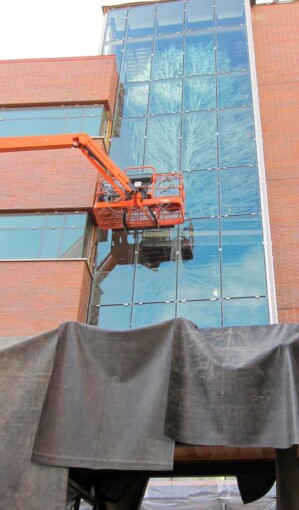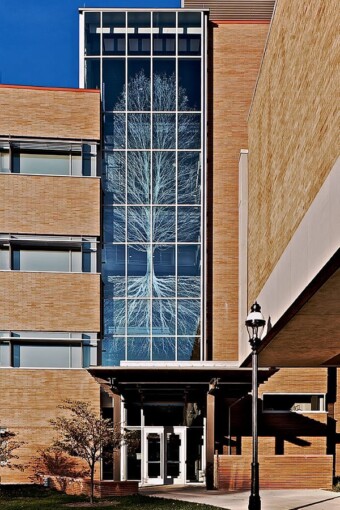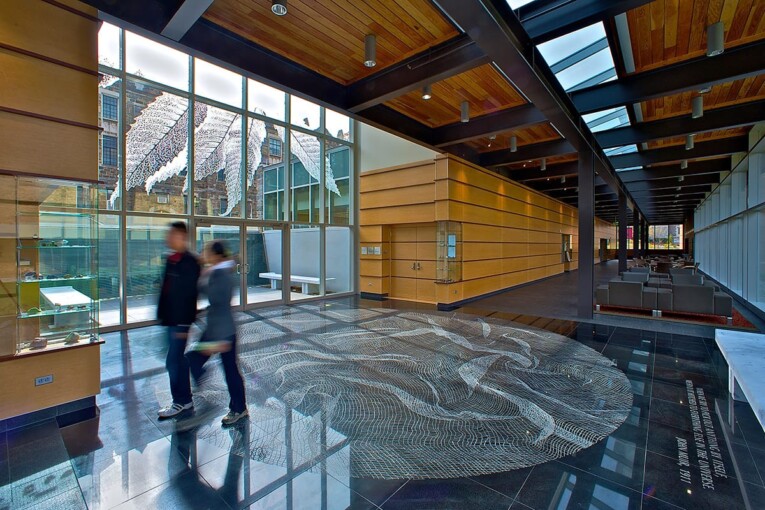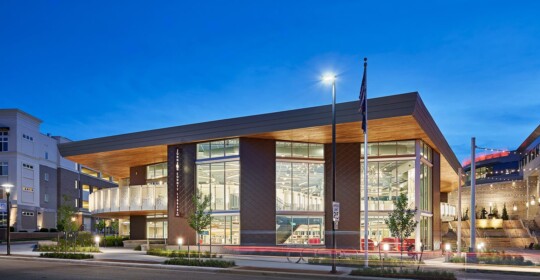
Lehigh University
Project Challenge:
Working with artist Larry Kirkland, Skyline Design was charged with creating two monumental etched panels—one glass curtain wall of 70 x 20 feet and one glass window measuring 15 x 22 feet—that reflected the mission of Lehigh University’s new STEPS (Science Technology Environment Policy Society) center. The two etchings were the largest single images Skyline Design had ever undertaken, the curtain wall spanning 28 panels and the window 12 panels.


Skyline Design’s Solution:
Skyline Design employed its proprietary Eco-etch® process to realize Kirkland’s vision on such a large scale. Skyline Design initially developed eco-etch as an alternative to traditional methods in which ceramic frit paint or ink is screen printed or rolled onto sheets of glass and then fused to the surface with heat treatments. Eco-etch, in contrast, is an environmentally friendly process that lightly abrades glass surfaces with a recyclable, specially formulated oxide powder, which can be reused for up to six months. No harsh chemicals or acids are used in the eco-etch process.

Result:
The Eco-etch process was fully in keeping with the ethos and purpose of Lehigh’s environmental studies program and saved the university both time and costs compared to traditional processes. The final etched panels of both the complete vascular system of a hardwood tree and the locally significant American chestnut were seamlessly assembled and installed, allowing for generous light inside the building and enough transparency to view the rolling hills of Pennsylvania outside.
Process:
Artist Larry Kirkland began his process by interviewing administrators, faculty, and students of Lehigh’s STEPS program. These interviews allowed Kirkland to gather information about the program’s history, intent, curriculum, and priorities, and they were critical to his conception of the project. Kirkland focused on Lehigh’s specific locale—represented by the American chestnut, which was decimated by blight in the 1800s, radically affecting the landscape and economy—and the totality of a life cycle, embodied by his depiction of a complete hardwood tree, from roots to branches, stretching 70 feet. Kirkland had worked with Skyline Design on a previous project and had a high level of trust in its methods and quality control. With Skyline Design’s Eco-etch process, Kirkland’s vector files for the two designs could be transferred directly to glass as complete images, rather than being divided and prepared as individual screens for each panel, as would have been required by ceramic frit processes. Skyline Design was thus able to save valuable time and project costs as well as minimize the potential for error across such large-scale designs. The panels were then etched with recyclable aluminum oxide on the inside surface of the IGUs, assembled, and shipped to Pennsylvania for final installation. The eco-etch process optimizes energy use, minimizes water use, reduces waste, and utilizes low-VOC materials. Employing this process for the Lehigh STEPS building was thus particularly gratifying for Skyline Design, which has long been committed to the same ideals—environmental sensitivity, sustainable practices, and recyclable resources.

